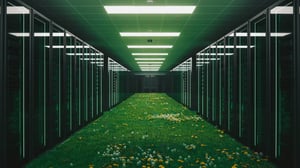
Colocation and Renewable Energy Certificates Can Help You Reach Sustainability Goals
Over the past 60 years, the annual growth rate of atmospheric carbon dioxide has increased nearly 100 times faster than previous increases. In 2022, the average global atmospheric carbon dioxide was at a record high of 417.06 parts per million. By the end of the century, the atmospheric carbon dioxide levels could reach conditions not seen for nearly 50 million years, if the global energy demand continues its rapid growth.1
There’s little wonder that organizations worldwide are rallying to mitigate this climate challenge. The European Green Deal strives for climate neutrality, starting by reducing greenhouse gas emissions by at least 55% by 2030. The U.S. and UK have pledged to reach net-zero emissions by 2050.
At the same time, energy-intensive technologies – like artificial intelligence, blockchain and augmented reality – are being adopted, consuming more energy and producing more carbon emissions. In response, businesses have intensified initiatives to limit their carbon footprint.

Sustainability strategies are gaining traction in many companies, large and small. Many data centers have implemented reduction goals, pledging to transition to a carbon-neutral footprint by utilizing renewable energy sources like wind and solar. They are also keeping sustainability in mind during data center design and enhancements, and even developing applications using green coding practices, all focused on energy efficiency. For example, CoreSite’s Boston data center, BO1, has an energy-efficient cooling system designed for sustainability. Recent upgrades result in an annual savings of eight million kilowatt-hours.
Data Centers: Powering Toward Greater Efficiency
Currently, data centers account for approximately 3% of the world’s carbon emissions – as much as 45% of that energy is attributed to cooling.3 Continually processing, storing and moving data propagates large amounts of heat that, in turn, drives cooling requirements.
Data center providers are acutely aware of the growing need for cooling solutions and look for more energy-efficient ways to control the data center environment. In addition to traditional HVAC systems and strategies such as hot-aisle and/or cold aisle containment configurations data centers are leveraging free cooling when and where possible. CoreSite uses free cooling in many of our data centers by integrating an economizer, like the plate and frame heat exchangers at BO1, allowing chillers to reduce operating levels and occasionally switch off completely, thereby reducing annual energy expenditure.
Liquid cooling is another approach that improves energy efficiency. With liquid cooling, chilled water is piped directly to the server racks to effectively cool the racks and hardware. With direct-to-chip cooling, liquid is circulated via tubes to cold plates directly adjacent to the hardware components. Remarkably, liquid cooling uses less water and energy than air cooling.
While larger data centers can focus their efforts on sustainability, many small-scale data centers or companies with on-premises data centers cannot optimize for energy and data storage demands. Colocation offers a solution. Because colocation aggregates data from many locations into centrally managed, larger scale, more efficient systems, the overall computing and carbon footprint is reduced, an advantage that is sometimes overlooked when thinking about moving from on-prem to colocation.
Renewable Energy Certificates: Tracking Green Energy Use
Even after optimizing for colocation and technology, enterprises may encounter challenges offsetting their greenhouse gas emissions. The lack of experienced resources and expertise to procure renewable energy, especially for small to mid-sized businesses, can make it daunting. So, how can these organizations support green initiatives?
Renewable energy certificates (RECs) allow businesses to support and claim green energy use at the right scale. RECs provide a means of buying and selling the (non-power) environmental attributes of renewable energy at a scale consistent with their specific energy usage. Essentially, businesses purchase and redeem enough of these certificates to meet their renewable goals and claim the environmental benefits of using electricity through renewable sources such as wind, solar and hydroelectric projects.
A REC is generated for every megawatt hour (MWh) of renewable energy created by a power supplier. Businesses purchase RECs and apply them against their green-energy goals by tracking the energy generated and proving it comes from a renewable source.

Whether the REC is used to meet mandated sustainability standards or to voluntarily boost their brand equity, RECs give businesses a mode to go green without directly purchasing the renewable power to do so.
Advancing Carbon Neutral Goals
For reducing carbon footprint, colocation and tech work hand in hand, as both strive toward carbon neutrality with energy-efficient and renewable solutions. To help our customers reach their ESG goals, we offer a Renewable Energy Certificates product in all our data centers to help you substantiate renewable energy use claims, meet regulatory requirements and demonstrate your commitment to sustainability.
CoreSite’s approach to energy reduction involves being more energy efficient and helping customers reach their sustainability goals. In 2022, we joined the Infrastructure Mason’s Climate Accord (ICA), a 150+ company co-op dedicated to reducing carbon in digital infrastructure materials, products and power.
Please come along with us on our sustainability journey. Together, we can grow a greener future.
1. Climate change: Atmospheric carbon dioxide (Climate.gov)
2. Most enterprise technology functions have set sustainability goals (Bain & Company)
3. How green is your data center? Optimize code to reduce greenhouse gas emissions (Forbes)
4. Climate change: The push to reduce IT’s carbon footprint (InfoWorld)










